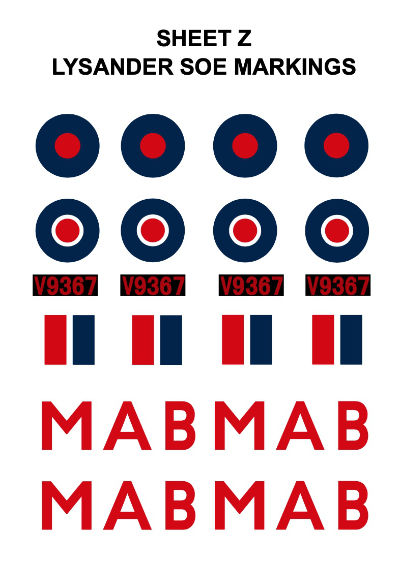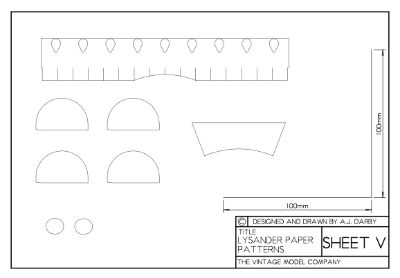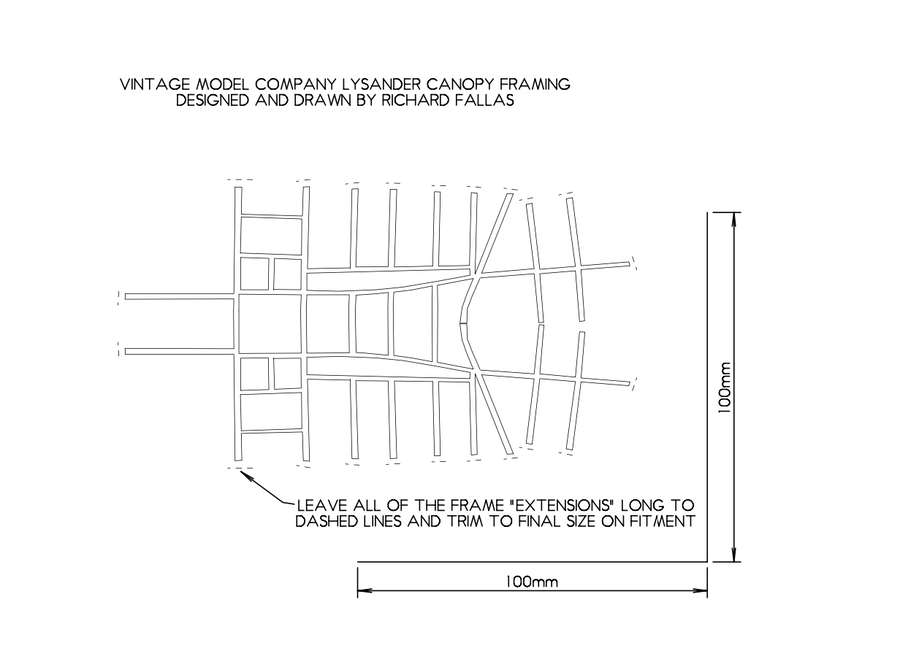THE LYSANDER - WESTLAND'S WONDER
First flown in 1936, the Lysander was selected to fulfil the air ministry contract A.39/34 for an army cooperation aircraft to replace the Hawker Hector. Before winning the contract W.E.W. ‘Teddy’ Petter, engineer son of the Chairman of Westland Sir Ernest Petter, interviewed RAF pilots to find out what they wanted in such an aircraft. This turned out to be good all round visibility, low speed handling and short take-off and landing (STOL) capability. Petter and designer Arthur Davenport produced, in appearance as much as anything else, an extraordinary aircraft that eventually became known affectionately as the ‘Lizzie’.
The design had a number of advanced features including fully automatic slats and flaps that gave it a very low stall speed as requested by the pilots. The Lizzie was, however, not without its foibles and pilots had to be particularly well briefed on procedures for take-off, landings and the engine controls before the ascent into the lofty perch of the seat in the all-round glazed cockpit.
In action supporting the British Expeditionary Force early in the war, the Lysander was not a great success. Although perfect for spotting duties in their own right, they were too easily picked off by enemy fighters when used in more aggressive roles and were quickly withdrawn and re-assigned. Many became used for the vital role of delivering assistance to RAF pilots forced to bail out over the sea, along with other more mundane patrol and delivery duties.
However, the Lysander eventually found its niche and most famous role, which exploited its STOL capabilities and powerful Bristol Mercury engine. These features, along with a robust undercarriage design, allowed the aircraft to land and take off from short, rough and hastily prepared airstrips. This made it ideal to drop off and retrieve Special Operations Executive (SOE) spy agents in France. They also delivered equipment such as radios and supplies destined for the French resistance as well as rescuing shot down air crews - all from behind enemy lines whilst rarely being detected by the occupying forces. Remarkably, given the difficulties these missions presented, it is reported that only one aircraft was lost performing these duties.
Retired from active duty by the RAF in 1946, a small number of these unique aircraft still exist and, at the time of writng, three are still in flying order in the UK and in Canada where a substantial number were produced in shadow factories.
YOUR KIT
This kit is for building a traditionally constructed, rubber powered, free flight model of a Lysander. The kit is provided with the materials (other than paints) to complete the suggested authentic scheme of an all-black Lysander V9637 that was used in night time clandestine operations by RAF Squadron No. 161, flying from RAF Tempsford and Tangmere between 1942 and 1945. This scheme was also applied to Lysander V9552 held by the Shuttleworth Collection near Bedford, UK in honour of V9637 pilot Peter Vaughan Fowler.
Construction of the model from this kit uses the traditional method of "stick and tissue", that consists of a built up balsa wood skeleton (framework), covered with a tissue skin. The balsa frameworks are built over a plan that is printed at the exact scale of the model, which is in essence a real engineering drawing. Power is provided by rubber strip motor that is wound up before flight.
Free flight means just that - once the model is launched, it is on its own. It must follow a predetermined flight path established when the model is initially adjusted for flight or "trimmed". This type of traditional building technique and flying requires a degree of patience and skill, but is extremely rewarding. Typically for a small model and in the spirit of the traditional kits, profiles are simplified and adjusted from the original and a relatively large propeller is used. This is done so that the model is light and stable enough to fly on its own, is simple in construction and can work with the rubber motor. These adjustments have been done with care and sensitivity so that the shape and spirit of the original aircraft is preserved as much as possible. Also in the spirit of the traditional kits, additional items required to build the model are things that can be found in the kitchen drawer or are easily available on the high street.
INCLUDED IN YOUR KIT
- Six balsa sheets with precise laser cut parts and strip wood.
- One set of plywood precise laser cut tailwheel parts and axle doublers
- PVA glue for building the wooden frames.
- One 150mm diameter plastic propeller.
- One pre-bent motor hook and shaft.
- One 60mm long piece of 10mm diameter balsa dowel for the engine cylinder heads.
- One 100mm long piece of 6.4mm diameter balsa dowel for the engine cylinders.
- Four low friction plastic nose bushings - two for the propeller and two for the undercarriage wheels.
- One 50mm length of 1.2mm Piano wire for the main undercarriage wheel axles.
- Three cocktail sticks - one for the motor peg and the other for making dowels
- FAI Super Tan rubber motor strip.
- Tissue to cover the model.
- One precisely moulded plastic spinner.
- One precisely moulded plastic exhaust collector.
- One precisely moulded clear plastic canopy.
- Parts reference sheets (W), full size summary plan sheets (X), scheme diagram sheet (Y) found in the back of the instruction booklet and scheme markings (Z) printed on lightweight paper
OTHER THINGS THAT YOU WILL NEED
Consumables
- Cyano-acrylate glue (sometimes called ‘superglue’), quick setting epoxy and a ‘glue stick’.
- Cling film or waxed paper to cover your plan or a wax candle to rub over it.
- One sheet of standard printer paper (80gsm).
- Tissue sealant - if you want to fly outdoors we recommend that you "dope" the model. EZE dope, traditional cellulose dope or hair spray-style lacquer are all options.
- Paints (Humbrol-style enamels) if you want to give your model an authentic scheme.
Tools
- A ‘building board’ – A flat piece of wood or cork that is large enough for the largest part of the model and soft enough for pins to be pushed into.
- Some modelling pins. If these aren’t available, dress making pins or drawing pins with tall heads will suffice.
- A sharp craft knife or scalpel.
- Pliers and wire cutters.
- 180 and 600 grit sandpaper and a small sanding block, or a disposable nail file with rough and smooth sides.
- A small engineers square or a plastic set square from a school geometry set.
- 30cm ruler (preferably steel).
- ‘Blu-Tack’ or plasticine.
- A fine marker pen.
- Brushes – one thin and fine, one flat and soft 10-12mm wide.
- An old perfume bottle or similar that can deliver a fine mist of tap water.
- Some sprung wooden clothes pegs to use as clamps.
Only Suitable For Ages 14+
Choking Hazard - Contains small parts, keep out of reach of children.
MARKINGS SHEET
Here is the markings sheet included in your kit for you to download and print out at home.
Click on the image to download the file.

PATTERNS SHEET
Here is the patterns sheet included in your kit for you to download and print out at home.
Click on the image to download the file.

CANOPY FRAMING TEMPLATE
Drawn by Richard Fallas, this template should help you to cut out tissue or vinyl framing for the Lysander canopy.
The vacuum formed canopies can vary in height slightly and so you may wish to cut the "legs" of the frame a little longer (marked with dashed lines) to fit your specific canopy!

UK SHIPPING
Most orders are shipped via Royal Mail’s Tracked 48 service.
We are in a very rural location and so our Royal Mail collection is at around 1pm.
Example:
An order placed before 12pm on Monday should be with you on Wednesday.
An order placed after 12pm on Monday should be with you on Thursday.
For larger or heavier orders, we use APC to deliver your package on a Next Working Day service.
Example:
An order placed before 10am on Monday should be with you on Tuesday.
An order placed after 10am on Monday should be with you on Wednesday.
Shipping is free to UK Mainland addresses for orders over £30.00, otherwise we charge £6.00 for Royal Mail Tracked 48 parcels and £12.00 for APC Next Working Day.
NORTHERN IRELAND
Unfortunately, for the purposes of the new EU GPSR regulations introduced on 13th December 2024, Northern Ireland falls under EU jurisdiction.
Until we have worked out how to comply with the new rules, we will not send items to Northern Ireland.
We are really sorry about this and hope to have a solution in place early in 2025.
SCOTTISH HIGHLANDS & UK ISLANDS
Royal Mail considers the Scottish Highlands and UK Islands as part of the UK and so does not charge a premium for deliveries.
Pretty much all other UK couriers have surcharges for deliveries to the following postcodes: IV, HS, KA27-28, KW, PA20-49, PA60-78, PH17-26, PH30-44, PH49-50, ZE, IM, TR21-25
If you live in one of these postcodes and the parcel size of your order is outside Royal Mail's dimensions, you will have to pay a surcharge.
Our system is not clever enough to work this out and so if your order attracts a surcharge, we will contact you before despatch to see if you would like to pay the surcharge and proceed with the order or cancel and receive a full refund.
INTERNATIONAL SHIPPING
EU COUNTRIES
On 13th December 2024, the EU introduced new regulations with respect to product safety called GPSR.
There was very little publicity or notice given to small UK businesses about the new regulations, but needless to say, to comply will be time-consuming, onerous and probably expensive.
Unfortunately, until we have worked out how to comply with the new rules, we will not send items to EU countries.
We are really sorry about this and hope to have a solution in place early in 2025.
Smaller items
Items that fit within Royal Mail International Tracked Medium Parcel parameters (59cm x 17cm x 15cm weighing less than 2kg) can be sent to most countries outside the UK.
For example up to 3 of our smaller 18” wingspan kits can fit into one of these parcels.
A parcel like this currently costs around £18 to send to the USA and will take up to 3 weeks to arrive. This is because Royal Mail hands over the parcel to the local Post Office service for your country who have to clear it through customs and then deliver it to you.
The Royal Mail tracking code also transfers over to the tracking for your country’s postal service.
Larger items
For items that do not fit within Royal Mail International Tracked Medium Parcel parameters, we use standard international couriers such as DHL, FedEx and UPS.
These companies use something called volumetric weights to calculate the cost of shipping.
For example, a Balsa Basics RC bundle kit that measures 102cm x 34cm x 16cm and weighs 2.5 kg is actually calculated at 14kg!
This makes these very expensive to send outside the UK - a large kit can cost nearly £60 to send to the USA.